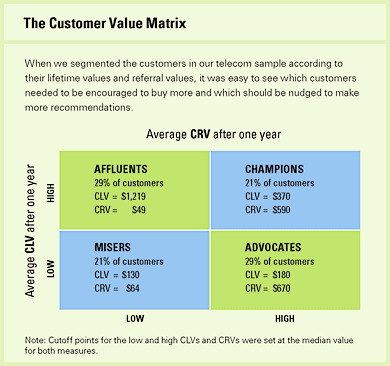13.2 Referral value (CRV)
“Referrals made by customers after a referral-incentive marketing campaign can be attributed to that campaign for about a year.” (V. Kumar, Petersen, and P.Leone 2007). Hence, we usually count those referrals made after one year of a campaign.
2 types of referral:
- Type-one referral: Would not join without referral.
- Type-two referral: still join without referral.
(V. Kumar, Petersen, and P.Leone 2007) estimated that each customer made about half type-one and half type-two referrals.
Referral value = PV(Type-one referrals) + PV(Type-two referrals)
where
- PV(type-two referrals) = the prevent value of the savings in acquisition costs.
\[ CRV_i = \sum_{t =1}^{T} \sum_{y = 1}^{n1} \frac{A_{ty} - a_{ty} - M_{ty} + ACQ1_{ty}}{(1+r)^t} + \sum_{t=1}^{T} \sum_{y = n1+1}^{n2} \frac{ACQ2_{ty}}{(1+r)^t} \]
where
- T = the number of periods that will be predicted into the future (e.g., typically 1 year)
- \(A_{ty}\) = the gross margin contributed by customer y who other otherwise would not have bought the product,
- \(a_{ty}\) = the cost of the referral for the customer y (this is what you set up)
- \(n1\) = the number of customers who would not join without the referral,
- \(n2-n1\) = the number of customers who would have joined anyway,
- \(M_{ty}\) = the marketing costs needed to retain the referred customers,
- r = semiannual discount factor ((V. Kumar et al. 2008) used .07238 = 15% annual rate)
- \(ACQ1_{ty}\) = the savings in acquisition costs from customers who would not join without the referral,
- \(ACQ2_{ty}\) = the savings in acquisition cost from customers who would have joined anyway.
Customers with high CLV does not guarantee high CRV (V. Kumar, Petersen, and P.Leone 2007). Hence, (V. Kumar, Petersen, and P.Leone 2007) proposed the customer value matrix

(Sunder, Kumar, and Zhao 2016) CLV in the consumer packaged goods industry
Objective: Propose a framework to assess Customer Lifetime Value (CLV) in the Consumer Packaged Goods (CPG) industry.
Challenges Addressed:
Multiple-Discreteness: Varied buying patterns.
Brand-Switching: Customers shifting between brands.
Budget Constrained Consumption: Customers’ purchasing limited by budget.
Key Features:
Bayesian Estimation: Enables inference of a consumer’s latent budget constraint using transaction data alone.
Brand-Level & Category-Level CLV: Shift from traditional firm-centric CLV models.
Implementation:
Applied to carbonated beverages category.
Demonstrated superiority over simpler heuristics and traditional CLV models.
Policy Simulations:
Explored budget constraint’s impact on CLV.
Analyzed asymmetric pricing effects and derived managerial insights.